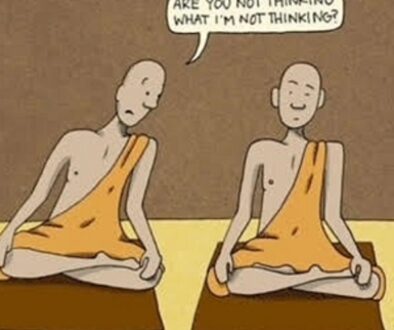On Passion, Intention, and Hitting the Mark Completely

On Passion, Intention, and Hitting the Mark Completely
To hit the mark completely means you have no new nest in which to settle.
~ Dogen
NISARGADATTA SAID THAT THE ONE THING required to reach enlightenment is earnestness. It’s quoted a lot. It’s probably referred to so often because it’s a plain-as-day truth that is overwhelmingly ignored, and thus those wiser than we are feel compelled to remind us of it again and again. What Nisargadatta did not do was define either earnestness or enlightenment. Let’s look at both.
The Merriam Webster Dictionary defines “earnest” as:
1: a serious and intent mental state
2: a considerable or impressive degree or amount
The same source defines “enlightenment” as:
1: the act or means of enlightening; the state of being enlightened
2: a final blessed state marked by the absence of desire or suffering
SO, FOR THE MOMENT, let us agree to accept those definitions, even if it’s only for the purpose of beginning this essay with some sense of outside objectivity to guide us. Having agreed, then we can go on to say that Nisargadatta appears to be telling us that in order to legitimately end suffering (barring some unaccountable, and therefore non-replicable miracle that defies the Law of Large Numbers), we must maintain a serious and intent mental state for a considerable length of time. Apparently this is where the line at the enlightenment door drastically thins. There are easily hundreds of thousands of seekers of all manner and stripe, in every conceivable geographic, political, spiritual and socio-economic position and damn few of them are finding stability within Nondual awareness. While the combined numbers could probably fill quite a large room, the percentages are surely infinitesimal. Granted, those who hold close to Nondual teachings for a while often get a glimpse or three. They could go on having them off and on for a lifetime. Most people never get off that merry-go-round. “Now I’m riding the pony, and next I’m watching the ride pass before me.” Sadly enough, as Adyashanti says, “One of the hallmarks of truth is that any piece of it always feels like all of it.” In this case, however, perception is not Reality. Can you say enlightened ego? God save us all.
WHAT ADYASHANTI DOESN’T SAY, at least not beyond his report of his own story of “pushing ever further”, is that if one holds to the integrity of the individual do-it-to-yourself task of maintaining a serious and intent mental state for a considerable length of time, meaning if one simply hangs on while exhibiting some small measure of humility, and dedication-to-task, then one can first come to distinguish between spiritual experiences and genuine awakening, and then come to distinguish the edge of truth from the center of truth. We can never feel what’s to come, but we can begin to feel what has not come. Once we quit trying to hold onto our preferred version of enlightenment, we can begin to open up, feel and find the actual Understanding. And not before.
THE GOOD NEWS BEING OFFERED HERE—the gospel of apparent individualism—is that none of these dismal numbers need apply to you. Any individual can agree to step down from specialness, and employ the Law of Large Numbers in reverse in regard to your own salvation. Find out what everyone else is doing and don’t do that! Stephen H. Wolinsky, a direct disciple of Nisargadatta’s, reports that early on the Sage asked him—I’m paraphrasing here—“Are you willing to stay the entire eight days, for the entire process?” So, by the great Sage’s own word, the primary “transmission” at least could take place in just over a week. From that point on, in was a matter of the seed working its way through earth and into air. The problem arises when the seed thinks it’s already a tree. It’s a common, predictable, understandable, ego-driven mistake that can best be avoided by our willingness to “remain open to outside teachings”, as Scott Kiloby has said. If we want to stay out of trouble, we can’t just reference the grandiose thoughts shooting around in our heads while believing we’re referencing truth.
THE CANDY OF SPIRITUAL EXPERIENCE is so sweet and bright that it’s blinding. It’s just what the ego ordered. Spiritual experiences are deliciously sensual. The Understanding is not. Spiritual experiences make the host body feel special. The Understanding makes the host body feel ordinary. Spiritual experiences are, by and large, incredibly enjoyable. The Understanding just is what is. That may or may not be pleasant. Following its dissolution, the absence of spiritual experience hurts, creating the craving for more, and the suffering of withdrawal. There is no absence of the Understanding. It’s always right now, or it’s not the Understanding.
IF WE LOOK AT NISARGADATTA’S WORK CLOSELY, we will see that he wasn’t much on candy. His teaching falls under the heading of Nondual philosopher as much or more so than it does spiritual teacher. He was as much of a spiritual adherent as he was a spiritual teacher, thus his daily devotions and bhajans. He never saw a reason to give them up.His personal practices were a conventional Hindu way of expressing love and gratitude. In his turn, he certainly allowed devotees to gather around him and offer gifts. Why not? To disallow personal devotion, or the devotion of others, is to arbitrarily divide reality up into what’s okay and what’s not. We call that dualism.
BUT HOW DID NISARGADATTA ACTUALLY TEACH? With logic, argument, and reason. He was often a difficult man, quick to anger and equally quick to drop it. Nisargadatta loved to debate; he thoroughly enjoyed engaging with his audience. He was above all, passionate: often loud, impatient, gesticulating wildly in the air. In a manner much like Shri Atmananda Krishna Menon’s, he would employ questions, examples, and concepts that took the individual and the assembly to their highest levels of thought again, and again, and again. With many tiny seeds planted he then waited for the watering of them, via the intuitive leap. Krishna Menon called this method accessing Higher Reason, which he said is beyond the mind. I’m not pretending to really comprehend Krishna Menon, but I visualize a sponge resting figuratively above the relative mind, and slowly soaking up esoteric lines of thought and ethereal concepts from the guru. As it gets full, the knowledge seeps downward, so to speak, in much the way that water does. The transfer is slow, subtle and almost entirely sub-conscious, therefore it occurs without noticeable resistance. We might note that the open use of logic, argument and reason also helps to put coming to the Understanding more into our own hands, and less in those of some lofty and capricious God of our own invention.
THINKING IS A GOOD THING. We are not trying to rid ourselves of thinking. I notice we can’t anyway. Granted, it’s good to be able to calm the mind, or at least to hold lightly the mind’s propensity to believe what it thinks, if we are going to be able to pay proper attention to inquiry, observation, reflection, or an organized teaching. In the end, however, mind is the only tool we have to slip around and go beyond it. As Ramesh Balsekar used to say, “We use the mind in the same way that we use one thorn to dig out another. When the job is done we throw away both thorns.” We don’t throw away thinking however; we simply let loose of the concepts that got us near home once we are home.
THE PRACTICE OF THINKING AND READING can’t directly cause enlightenment any more than meditation, chanting, drumming, japa, or any other practice could. Nothing directly causes enlightenment. It’s always already here; it can’t be caused. It can only be noticed. But practices of almost any sort can court and encourage awakening. Helpful potential is always available when we are expressing earnestness in action. And, perhaps even more importantly, thinking, reading, and frank, honest dialogue with a teacher can help one offer further invitation to whatever grace has already spontaneously arisen. Only ego would want to get to “the end” of enlightenment. What end? (What enlightenment, for that matter, but that’s another column.) Only ego would see peace and freedom as a pair of goal posts to drive through so that we can spike the ball in the end zone. That arrogant movement is utter nonsense. Yet it’s quite common, and always leaves suffering—and enlightenment, in its wake. Again and again and again: Self-realization really is all about right now.
ABIDANCE, ONE OF THE MOST MISUNDERSTOOD terms in modern spirituality. At least as it is considered here, it is simply the ever-present recognition of Reality as it is. It’s not volcanically mystical. It’s not blissfully spiritual. It is the calm, quiet, plain old, everyday conscious awareness of the extraordinary ever-present nature of reality which is underlying and supporting the altogether common and ordinary. Thus, it it is seen that there is no “ordinary”. So long as we remain open, there is endless room for further opening. Abidance, like an initial true seeing, is not the end of the line. It is the beginning of another. Like snakes, we shed our skins so that we can continue to grow. Enlightenment is a verb. No, the Absolute doesn’t need broadening, or deepening, or growing. Yet let’s not forget that it’s still coming through a markedly limited being. The relative presence or absence of filters and conditioning will still color the perceptions of the host. It’s not about being perfection; it’s about seeing perfection as it already is–through the maze of apparent flaws that serve to construct all of Life, and all of humanity. The Understanding is not about bailing out of, or off-loading of our humanness. The true Middle Way is about being open to, and experiencing both the absolute and relative aspects of Oneness simultaneously. It is entirely about inclusion, not exclusion.
IN CONTRAST TO THE “END OF ENLIGHTENMENT,” the end of seeking is a fine thing indeed! One soon finds, however, that the end of seeking is also about right now. Are we enlightened to this current movement, or are we still seeking something with it or beyond it? Resistance is seeking. It’s seeking an out, an alternative to what is right in front of us, whether it’s mental or actual; whether it’s past, present, or future. The end of seeking for any period of time is like a cleansing shower for anyone who’s been caught up in the compulsive seeking cycle for any length of time. Many people would be delighted to return to complete unconsciousness rather than be caught in the seeker cycle. Lots do. Some can’t. For the “can’ts” it is discovered that the seeking process is not at all about the individual. Somewhere along the way our path (far further back than most of us suspect) has been totally commandeered by an “outside force”. We can’t go back and we can’t go forward, and it is rather like a self-reinforcing disease. It is the complete, penetrative witnessing of this inherent helplessness that stems the collapse of the dream self—at least long enough for the crucial passing through the “Gateless Gate”. Any attempt to then personally claim, or personally grasp that spontaneous happening is like Sleeping Beauty touching a thorn. We are back soundly asleep in an instant.
THIS IS WHAT DOGEN MEANT by “no new nest.” The natural movement of the still-present conditioning is to utilize any new information toward its own self-interest. It’s not wrong or wicked; it’s hard-wired human nature. It’s fine. What isn’t fine, at least if we want to remain consciously nestless, is to believe what our minds are telling us. Mind is a clever master, and the brain is a powerful tool that’s going to used either for us or against us. It takes the combination of a lot of willingness and at least a little humility—which we might label as “earnestness”—if we are to maintain a serious and intent mental state for a considerable length of time, and thus remain nestless among opinions and positions, and thereby remain free from personal suffering.
Housekeeping Notes:
Let me welcome Israel and Latvia to the growing list of countries visiting Awakening Clarity. They join 46 other countries that are already helping to awaken Clarity. We are growing like a weed; with a large leap in the number of visits-to-a-single-post recorded this week. Thank you for your kind attention, and thank your graciousness in passing this site on to others. It’s this kind of feedback that lets me know how well I’m communicating This, as it is seen and experienced from here. I hope to see you next week!



